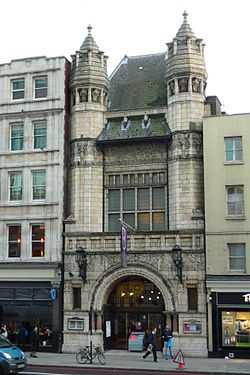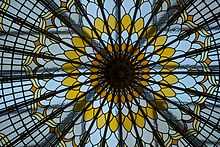Bishopsgate Institute
| Bishopsgate Institute | |
|---|---|
 | |
| Established | 1895 |
| Location | 230 Bishopsgate, London, EC2M 4QH |
| Public transit access |
Liverpool Street Station |
| Website | www.bishopsgate.org.uk |
The Bishopsgate Institute is a cultural institute in London, located on Bishopsgate, near Liverpool Street station and Spitalfields market. The Institute was established in 1895, and describes itself as a "home for ideas and debate, learning and enquiry and as a place where independent thought is cherished". It offers a cultural events programme, courses for adults, historic library and archive collections and community programme.
History
The Grade II* listed building was the first of the three major buildings designed by architect Charles Harrison Townsend (1851–1928). The other two are the nearby Whitechapel Gallery and the Horniman Museum in south London. His work combined elements of the Arts and Crafts movement and Art Nouveau style, along with the typically Victorian.
Since opening on New Year's Day 1895, the Bishopsgate Institute has been a centre for culture and learning.
The original aims of the Institute were to provide a public library, public hall and meeting rooms for people living and working in the City of London. The Great Hall in particular was erected for the benefit of the public to promote lectures, exhibitions and otherwise the advancement literature, science and the fine arts.
The Bishopsgate Institute was built using funds from charitable endowments made to the parish of St Botolph's, Bishopsgate. These had been collected by the parish for over a period of 500 years, but a scheme agreed by the Charity Commissioners in 1891, enabled these to be drawn together into one endowment. Reverend William Rogers (1819–1896), Rector of St Botolph's and a notable educational reformer and supporter of free libraries, was instrumental in setting up the Institute and ensuring that the original charitable aims were met.
Bishopsgate Library

Bishopsgate Library is a free, independent library, open every weekday.
Bishopsgate Library holds important historical collections about London, the labour movement, free thought and cooperative movements, as well as the history of protest and campaigning.
The archive at the Bishopsgate Library holds over 20,000 images in three collections – The London & Middlesex Archaeological Society (LAMAS) Glass Slide Collection, the London Co-operative Society and the London Collection Digital Photographs. They have recently shared some of their images from LAMAS in 1977 on Historypin. This collection contains images of many of London’s famous landmarks, including churches, statues, open spaces and buildings, as well as images showing social and cultural scenes from the early 20th century.[1]
Its librarian between 1897 and 1941 was Charles Goss, who argued against the trend to create open access libraries and innovated descriptive cataloguing to improve closed access discovery. His papers are held at the institute's archive.[2][3] He established their special collections in London history, labour history, free-thought and humanism.[4]
Cultural events
Bishopsgate Institute programmes a range of cultural events throughout the year. Many of these are inspired by Bishopsgate Library's historical and radical library and archive collections. They include a range of talks, walks and debates, as well as free lunchtime concerts in the historic Great Hall.
Past talks and debates at the Bishopsgate Institute have included:
- Building East London: a season of talks, walks and debates curated in collaboration with Dan Cruickshank about architectural development in the East End
- Kenan Malik and Tariq Modood MBE on the legacy of the fatwā against Salman Rushdie, author of The Satanic Verses
- Actor and director Steven Berkoff in conversation with historian Michelle Johansen about his memories of growing up in the East End of London
- Tony Benn discussing the labour movement, socialism and democracy
- Leading authority on Charles Dickens, Michael Slater, discussing Dickens's relationship with London
- London Lore, a one-day conference examining the history of London's folklore traditions
- Iain Sinclair, Sheila Rowbotham, Rachel Lichtenstein, Patrick Wright and Michael Rosen discussing the fate of the London Borough of Hackney
- Author Adam Foulds on his 2009 Man Booker Prize shortlisted book The Quickening Maze
- Writer and historian Jerry White talking about the extraordinary rise of London
- Journalist Anna Minton in conversation with author Michael Rosen about fear and happiness in the 21st-century city
- Gothic London, a talk by Roger Luckhurst about the Gothic genre in the 19th and 20th centuries
- Historian, broadcaster and politician Tristram Hunt discussing the life of Friedrich Engels
Popular talks are also available as podcasts.
Courses for Adults
Bishopsgate Institute offers a full programme of courses for adults. All courses have been developed for complete newcomers, and there are advanced levels in many of these subjects too. The classes run during lunch times and afternoons, and after work. Subjects typically include:
Arts and Culture: Practical Photography, Wine Tasting, Art History and Appreciation, Sketching, Walking Tours, Introductions to Classical Music and Film History
Words and Ideas: Creative Writing, Scriptwriting, Philosophy and Intensive Public Speaking
Languages: French, Spanish, Italian, German, Japanese, Chinese Mandarin and Russian
Performing arts: Salsa, Flamenco, Tango, Ballroom, Rock and Roll/Jive, Acting and Singing
Body and exercise: Pilates, Yoga and Meditation
Hall and room hire
Bishopsgate Institute has meeting space available for hire, including the Great Hall. These can host meetings, events or training sessions.
Supporting the local community
Bishopsgate Institute runs a programme dedicated to supporting people in the local community. It does this by focusing on two main areas of activity:
A pensioners club which provides monthly lunches, regular outings and a quarterly top-up pension to a group of 55 local residents
A grant award scheme which is open to local organisations who help people in need, hardship or distress and who have resided or worked in the parishes of St. Botolph’s Bishopsgate, Christchurch Spitalfields and St. Leonard’s Shoreditch
See also
References
- ↑ Bishopgate Institute on Historypin
- ↑ "Bishopsgate Institute - Charles Goss". Home › Library › Library and Archive Collections › London History › Goss, Charles. Bishopsgate Institute. Retrieved 31 July 2012.
- ↑ Harris, C. W. J. (1970). "Charles Goss (1864-1946): Portrait of a Reactionary". Library world.
- ↑ "Special collections in the heart of the city: Bishopsgate Library". Copac. Retrieved 2 August 2012.
External links
- Official website
- THE BISHOPSGATE FOUNDATION, Registered Charity no. 1090923 at the Charity Commission
Coordinates: 51°31′7.28″N 0°4′45.54″W / 51.5186889°N 0.0793167°W